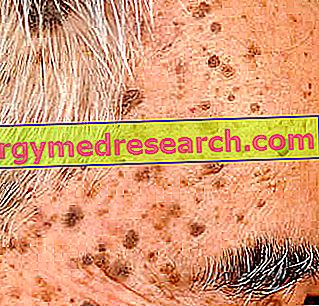What is Seborrhoeic Keratosis
Seborrheic keratosis is a benign tumor that affects the skin; it manifests itself with brownish-brown speckles generally in relief. The surface of the areas affected by seborrheic keratoses tends to become scaly and form greasy crusts prone to break off.

See other Photos Seborrhoeic keratosis
Unlike actinic keratosis - with which it must not be confused - seborrheic keratosis does not evolve into malignant pathologies.
Incidence
Seborrheic keratoses occur very frequently in the face and trunk of subjects who have reached the advanced average age, without preference for sex. The dermatological disorder manifests itself above all in the Caucasian race, while it is rare for Orientals and blacks to be affected.
Causes
Etiopathological research is still a reason for study. The only connection that scholars were able to prove was familiarity : it seems that seborrheic warts are genetically transmitted in an autosomal dominant way.
It is certain, however, that the growth, therefore the evolution, of seborrheic keratoses is enhanced by hormonal alterations or irritation, although not constituting the triggering cause: for this reason menopause, a time of high hormonal modulation, coincides with the strengthening of warts seborrheic.
Finally, some studies also suggest a possible involvement of UV radiation in the etiology of the disease, since it was noted that seborrheic keratosis occurs in people who have exposed their skin to the sun for prolonged periods. However, since the disorder occurs even in individuals who have not been excessively exposed to UV radiation, the debate about the implication or not of solar rays in the etiology of seborrheic keratosis is still open. Therefore, more and more in-depth studies need to be conducted.
Clinical manifestations
Usually, seborrheic keratoses begin with yellowish papules that brown and flake off over time. In truth, the color of the lesions can vary from hazel to brown or blue depending on the subtype of seborrheic keratosis that afflicts the patient. Furthermore, although the lesions occur more frequently on the face and trunk, depending on the subtype of seborrheic keratosis from which one suffers, these can also occur in other parts of the body. (see "Classification" paragraph).
The papules can be of different sizes, depending on the subject and on the area affected by the keratosis: in general, there is a diameter from 1 millimeter to 1 centimeter, but there have been cases in which the papules are even more evolved .
Often, seborrheic keratoses appear to be just laced to the skin and give the sensation of easily falling off. Precisely because of the precariousness with which seborrheic keratoses are attached to the skin, it is not uncommon for them to be eradicated, partially or completely, following a trauma.
Given the similarity with warts, seborrheic keratosis is known as the seborrheic wart : seborrheic formations are neither contagious nor infectious and, as mentioned, cannot evolve into malignant tumors.
Symptoms
The lesions typical of this skin disorder are generally asymptomatic and do not cause any kind of discomfort. However, in some cases the lesions may become irritated or cause itching and / or bleeding.
Classification
Various subtypes of seborrheic keratosis are identified:
- Seborrheic acanthosic keratosis : it is the most frequent form, which presents a diffused pigmentation from hazel to dark brown with pseudo-corneal cysts which tend to take on a yellowish color.
- Seborrheic Keratosis Acroposta or Keratosis Stucco: it mainly affects the legs and the skin lesions are multiple.
- Hyperkeratotic seborrheic keratosis: keratotic manifestation that tends to flake off continuously.
- Pigmented seborrheic keratosis or melanoacanthoma: the keratotic form manifests multiple pigmentations and the presence of melanocytes is abundant.
- Sore ( irritated ) seborrheic keratosis: the seborrheic keratosis manifestation is accompanied by irritations and other possible skin alterations. Bleeding and redness of the injured areas occur. Usually, the infiltration of melanophages in the aforementioned areas gives a bluish color to the spots, sometimes causing diagnostic doubts (complicated distinction from the basal cell pigmented epitelioma).
- Dermatosis papulosa nigra ( seborrheic keratosis on dark skin ): regarding this dermatological disease, it is not yet clear whether it can be considered a variant of seborrheic keratosis. It manifests itself with small multiple hyper-pigmented spots.
Diagnosis

If the diagnosis of seborrheic keratosis is safe, the removal of warts would be useless (unless the disorder appears a serious aesthetic problem in the eyes of the affected subject). Through dermatoscopy, the specialist is able to make a correct diagnosis and differentiate seborrheic keratosis from other skin diseases. Of course, the medicò will also have to identify which type of seborrheic keratosis is affecting the patient.
Treatment
As mentioned, treatments for the removal of seborrheic warts are not necessary, except for aesthetic reasons. In fact, the lesions are generally asymptomatic and do not cause any discomfort to the patients. However, if the seborrheic keratoses present an unregulated and excessive growth, the disorder could have considerable aesthetic repercussions.
In this case, diathermocoagulation, cryotherapy, laser, curettage or electrocautery are possible solutions for the elimination of seborrheic keratoses.
At the same time, the aforementioned therapeutic approaches can be adopted in the event that the lesions become annoying, becoming irritated and causing itching, pain and / or bleeding.

However, the treatment leads to a permanent removal of the lesion, as this will no longer occur in the area where it was eliminated. However, this does not prevent the appearance of new seborrheic keratoses in other untreated areas of the body.
Summary
To fix the concepts ...
| Disease | Seborrheic keratosis or seborrheic wart |
| Clinical aspects | Non-contagious, non-infectious disease of a benign nature. It manifests itself with brown-brownish spots in relief; the surface of the papules is rough, characterized by scales and unctuous crusts that come off. Generally, the diameter of the patches varies from 1 mm to 1 cm. Sometimes, the skin disorder is related to an annoying itching sensation. |
| Incidence | Seborrheic keratoses occur in subjects who have reached the advanced average age, without preference for sex; the dermatological disorder manifests itself above all in the Caucasian race, while it is rare in the Orientals and blacks. |
| Interested areas | Face and trunk |
| Differences with actinic keratosis | Seborrheic keratosis is not a pre-neoplastic form and is not caused by exposure to UV rays. |
| Cause | She is not clear. Probably genetically transmitted in an autosomal dominant way. It is potentiated by hormonal alterations and by immunodepression. |
| Damage | Purely aesthetic |
| Classification |
|
| Possible treatments to eliminate seborrheic keratosis |
|



